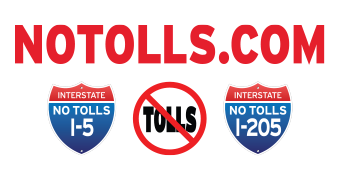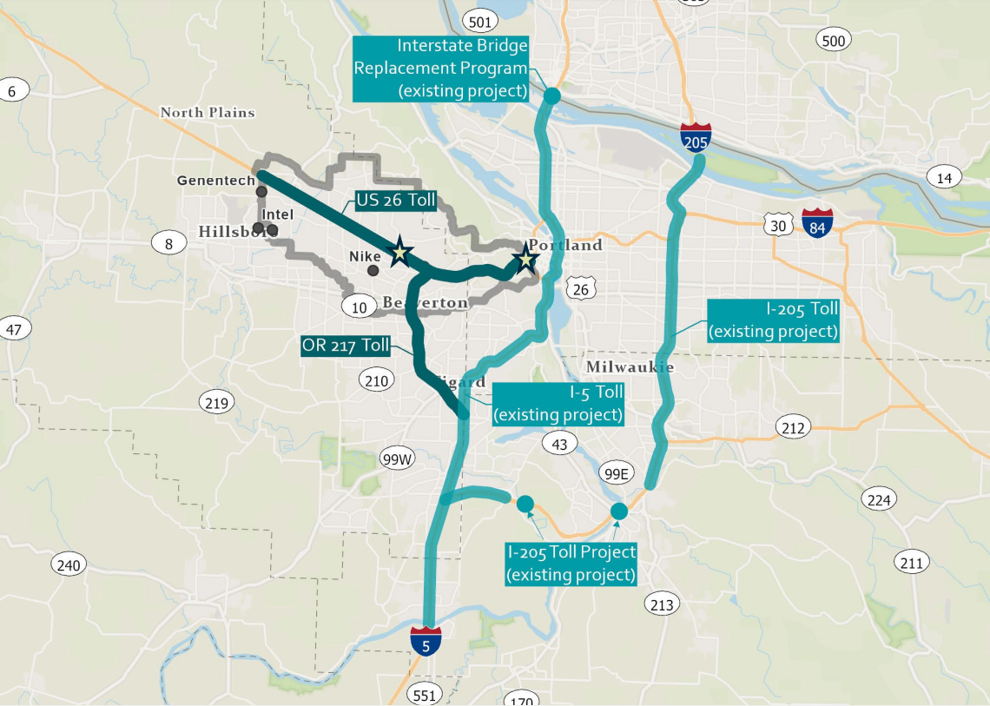Expanding unpopular tolls to fund multi billion dollar westside transportation projects
By Holly Bartholomew
Updated
While Oregon’s discussions on freeway tolling in recent years have focused almost entirely on I-205 and I-5 in the Portland area — a prospect that is not popular, particularly with Clackamas County residents — for the past year and a half, a group convened by the Oregon Department of Transportation and Metro has been examining highway tolls for the westside of the Portland Metro region.
ODOT, Metro and officials from throughout Washington and Multnomah Counties have studied tolling on U.S. 26 and Highway 217 as part of the Westside Multimodal Improvement Study.
According to its charter, the WMIS is a comprehensive look at how goods and people move throughout the western half of the metro area today and 20 years into the future.
The agencies involved in the study are looking to address and anticipate transportation issues for westside residents, workers, commuters and transit users.
The ultimate goal of the study is to recommend plans, projects and strategies to accommodate the current and future needs of West Portland and its surrounding area. A steering committee for the WMIS has met regularly since May 2022.
As recommendations for the study’s final report, the steering committee — which is made up of officials from Metro, ODOT, Washington and Multnomah Counties, the cities of Hillsboro and Beaverton, the Portland Bureau of Transportation, the Asian Pacific American Network of Oregon, Centro Cultural, Greater Portland Inc, TriMet and Washington County Chamber of Commerce — focused on tolling along U.S. 26 and Highway 217 along with a number of strategic capital improvements funded by the tolls.
Officials from the study’s project management team emphasized that there will be further studies of the projects and policies recommended in the WMIS.
“We know that funding will be needed in order to continue the inquiry as we go forward,” said Clifford Higgins, Metro’s communications manager for planning, development and research.
Higgins also mentioned the study began as a request from Washington County business leaders to former Gov. Kate Brown to find transportation solutions for this area.
“A lot of the issues that were heard during this process include limited transit options, safety concerns and inadequate access for bike and pedestrians,” Higgins said. “Business representatives also shared concerns about congestion impacting the flow of their goods, their workers, easy commutes and the safety along freight routes.”
Washington County, also known as the Silicon Forest, is home to some of the state’s largest employers. In the next 50 years, the county is projected to grow in population by 40-55% and see employment growth of 100-145%, according to figures from the Washington County Transportation Futures Study. However, according to business leaders in the area, congestion on U.S. 26 and the surrounding area is one of the biggest challenges to growth, as noted in the WMIS Issues, Needs and Problems Statement.
As discussed by members of the steering committee at the Nov. 2 meeting, the region’s employers would like to see travel times become more reliable for their goods and employees moving in and out of the region.
How the WMIS envisioned tolling
The WMIS analyzed possible tolls on U.S. 26 from Brookwood Parkway to the Vista Ridge Tunnel and on all of Highway 217. The tolling scenario presented to the steering committee included a base toll for all cars on these roadways plus variable rate tolls for two high congestion areas on U.S. 26: just outside the Vista Ridge Tunnel and between Cedar Hills Boulevard and Murray Boulevard.
At a meeting Nov. 2, the project management team told the steering committee that these tolls, with no additional improvements in the area, would reduce overall delay due to congestion on U.S. 26 by about 50%, though it would lead to more delay on nearby arterial roads due to diversion traffic, according to the calculation model used for the study.
According to the model, travel times would be better on U.S. 26 in 2045 than they are today. If no tolling is implemented and no improvements are made, travel times would be about twice as long as they are today on Westbound U.S. 26 and nearly 20% longer for eastbound traffic in 2045.
The study also showed more drivers would shift to transit use or carpooling as a result of the tolls.
In addition to tolling, the steering committee would like to see phased improvements on U.S. 26, I-405 and Cornelius Pass Road, as well as investments in transit options and improvements to routes that would likely see diversion to the tolls.
A change in ODOT’s plans?
The prospect of tolls on the westside of the metro area may come as a surprise to Oregonians, particularly those in Clackamas County where pushback to tolls on I-205 was fierce enough to prompt Gov. Tina Kotek to implement a pause on all tolls until 2026.
The FAQ on ODOT’s tolling page emphasizes that the department is only working on tolls for I-5 and I-205 because the Oregon Legislature granted authorization for those toll projects through House Bill 2017.
One question on the FAQ page asks “Will other Portland area highways be tolled?” to which the response is “We are not currently evaluating additional corridors. Any future analysis of additional corridors would build on our current work on I-5 and I-205.”
In fact, the seeming imbalance of tolling only east of I-5 has rankled feathers of leaders in Clackamas County. This fall, West Linn Mayor Rory Bialostosky emailed a tersely-worded letter to ODOT leadership in which he lamented the seemingly undue burden of tolls for Clackamas County residents, while state money went to the Highway 217 project, which was not slated for tolling.
In response, ODOT Urban Mobility Office Strategic Initiatives Director Mandy Putney wrote, “The legislative direction we received in 2017 and 2021 was to implement tolls on I-5 and I-205 because these are critical freight and lifeline routes for our region. At that time, lawmakers faced challenges we continue to face today: we have aging bridges and roads and congestion that impacts our day-to-day lives and statewide economy.”
Putney also pointed out the I-205 Abernethy Bridge Project was about $500 million more than the Highway 217 project, and thus received significantly more money from the statewide transportation fund.
Asked about tolling as part of the WMIS despite statements like this, Jenny Cherrytree, a spokesperson for ODOT’s Urban Mobility Office, stated the WMIS recommendations are not ODOT’s recommendations.
The committee came together to discuss potential solutions to congestion and tolling happened to be one solution the committee recommends studying further, Cherrytree explained.



One comment
John Courtney
February 21, 2024 at 2:45 am
I support NoTolls. But realize they are going in. No matter how u popular they are with majority of us. My parents who are a fixed income will pay an estimated $20 each visit. Supporting the Thorns will cost us $20 estimated each game, besides or parking fee of $15. Majority doesn’t matter anymore. It’s all about funding PERS and other unwanted on sustainable projects